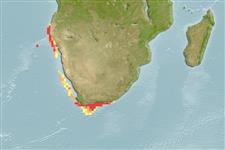Environment: milieu / climate zone / depth range / distribution range
экология
морской; пределы глубины ? - 450 m (Ref. 36731). Tropical
Southeast Atlantic: South Africa and Namibia.
Length at first maturity / Size / Вес / Возраст
Maturity: Lm 9.5 range ? - ? cm
Max length : 17.0 cm SL самец/пол неопределен; (Ref. 36731)
Краткое описание
определительные ключи | морфология | морфометрия
Diagnosis: It hardly differs from the European anchovy (Engraulis encrasicolus); of other anchovies in southern and eastern African waters, species of Stolephorus have 3 to 7 sharp needle-like scutes along the belly, while species of Thryssa have compressed bodies and a keel of scutes along the belly (Ref. 189).
Pelagic in coastal waters, but down to a depth of about 400 m (Ref. 30573). It feeds on planktonic organisms (Ref. 30573). Larvae and juveniles were observed to be selective, raptorial carnivores and switched to non-selective filter feeding omnivory when adults. Caught with purse seines in South Africa and Namibia (Ref. 80687).
Life cycle and mating behavior
половая зрелость | размножение | нерест | икра | Fecundity | личинки
Bianchi, G., K.E. Carpenter, J.-P. Roux, F.J. Molloy, D. Boyer and H.J. Boyer, 1999. FAO species identification guide for fishery purposes. Field guide to the living marine resources of Namibia. FAO, Rome. 265 p. (Ref. 36731)
Статус Красного Списка МСОП (Ref. 130435: Version 2024-2)
Угроза для людей
Harmless
Использование человеком
рыболовство: коммерческий
дополнительная информация
инструменты
Специальные отчеты
Скачать в формате XML
ресурсы в Интернет
Estimates based on models
Preferred temperature (Ref.
123201): 10.2 - 16.7, mean 13.7 °C (based on 40 cells).
Phylogenetic diversity index (Ref.
82804): PD
50 = 0.5020 [Uniqueness, from 0.5 = low to 2.0 = high].
Bayesian length-weight: a=0.00457 (0.00213 - 0.00980), b=3.12 (2.95 - 3.29), in cm total length, based on LWR estimates for this Genus-body shape (Ref.
93245).
Trophic level (Ref.
69278): 3.0 ±0.1 se; based on size and trophs of closest relatives
Generation time: 1.2 ( na - na) years. Estimated as median ln(3)/K based on 1
growth studies.
устойчивость к внешним воздействиям (Ref.
120179): высокий, минимальное время удвоения популяции до 15 месяцев (Preliminary K or Fecundity.).
Prior r = 0.42, 95% CL = 0.28 - 0.64, Based on 2 full stock assessments.
Fishing Vulnerability (Ref.
59153): Low vulnerability (11 of 100).
Climate Vulnerability (Ref.
125649): Low to moderate vulnerability (26 of 100).
Nutrients (Ref.
124155): Calcium = 347 [143, 896] mg/100g; Iron = 1.54 [0.71, 3.72] mg/100g; Protein = 17.9 [16.6, 19.3] %; Omega3 = 0.625 [0.326, 1.241] g/100g; Selenium = 50.5 [20.5, 129.2] μg/100g; VitaminA = 19.5 [4.1, 89.8] μg/100g; Zinc = 1.66 [0.99, 2.78] mg/100g (wet weight);
